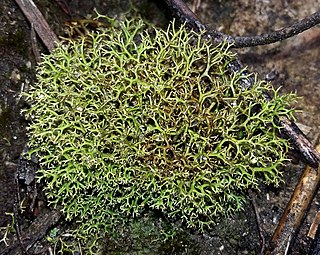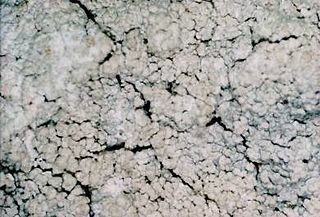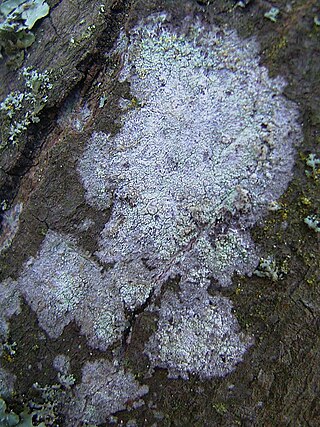
Ochrolechia is a genus of crustose lichens in the family Ochrolechiaceae. These lichens typically form uneven, often thick, crust-like growths on various surfaces and are characterised by their white to pale grey thalli, which may have a greenish tint. The genus has a long evolutionary history, with fossils dating back to the Paleogene period, about 34 million years ago. Ochrolechia species have disc-like apothecia, which are usually yellowish or brownish-pink and often covered with a fine white powdery coating. The genus is widely distributed and includes both common and rare species, with some found in extreme environments such as arctic and alpine regions. Ochrolechia lichens produce diverse secondary metabolites, including orcinol depsides, depsidones, and xanthones.

Cladia is a genus of lichen-forming fungi in the family Cladoniaceae. Cladia species have a crustose or squamulose (scaly) primary thallus and a fruticose, secondary thallus, often referred to as pseudopodetium. The type species of the genus, Cladia aggregata, is widely distributed, occurring in South America, South Africa, Australasia and South-East Asia to southern Japan and India. Most of the other species are found in the Southern Hemisphere.

Thelotrema is a genus of lichen-forming fungi in the family Graphidaceae, the family to which all taxa in the former Thelotremataceae now belong.

Micarea is a genus of lichen-forming fungi in the family Pilocarpaceae. The widely distributed genus contains 142 species and new species are described actively. Species in the genus are crustose lichens and their photobiont is a single-celled green alga.

Amandinea is a genus of lichenized fungi in the family Caliciaceae. Genetic studies indicates that the genus Amandinea and Buellia are the same, although this is not widely accepted.
Endococcus is a genus of lichenicolous (lichen-dwelling) in the family Lichenotheliaceae. It has 44 species. The genus was circumscribed by the Finnish botanist William Nylander in 1855. Although at least one source places the genus in the Verrucariaceae, a 2016 study of the type species, Endococcus rugulosus, determined that it should instead be placed in the family Lichenotheliaceae of the order Dothideales; this classification echoes a placement proposed in 1979 by David Hawksworth.
Everniopsis is a fungal genus in the family Parmeliaceae. It consists of a single species, the bark-dwelling lichen Everniopsis trulla, which occurs in Africa and South America.

Lecidella is a genus of crustose lichens in the family Lecanoraceae.

Peltula is a genus of small dark brown to olive or dark grey squamulose lichens. These lichens typically grow on rocks in arid and semi-arid environments worldwide. They consist of a fungus living in symbiosis with a photosynthetic partner, specifically a cyanobacterium of the genus Chroococcidiopsis. Peltula is the only genus in the family Peltulaceae, which belongs to the Lichinomycetes, a class of fungi that form lichens. The genus includes about 50 recognised species, which exhibit a variety of growth forms ranging from flat and crust-like to more complex, leaf-like structures. Peltula lichens play important ecological roles in harsh environments, contributing to soil stability and nutrient cycling.

Rhizocarpon is a genus of crustose, saxicolous, lecideoid lichens in the family Rhizocarpaceae. The genus is common in arctic-alpine environments, but also occurs throughout temperate, subtropical, and even tropical regions. They are commonly known as map lichens because of the prothallus forming border-like bands between colonies in some species, like the common map lichen.

Lepraria is a genus of leprose crustose lichens that grows on its substrate like patches of granular, caked up, mealy dust grains. Members of the genus are commonly called dust lichens. The main vegetative body (thallus) is made of patches of soredia. There are no known mechanisms for sexual reproduction, yet members of the genus continue to speciate. Some species can form marginal lobes and appear squamulose. Because of the morphological simplicity of the thallus and the absence of sexual structures, the composition of lichen products are important characters to distinguish between similar species in Lepraria.

Phlyctis is a genus of lichenized fungi in the order Gyalectales, and the type genus of the family Phlyctidaceae. Members of the genus are commonly called blemished lichens.

Megalaria is a genus of lichen-forming fungi in the family Ramalinaceae. It contains 44 species of crustose lichens, the majority of which grow on bark.

Loxospora is a genus of lichen-forming fungi in the family Sarrameanaceae. It has 13 species. The genus was circumscribed by Italian lichenologist Abramo Bartolommeo Massalongo in 1852, with Loxospora elatina assigned as the type species. This crustose lichen was originally named Lecanora elatina by Erik Acharius in 1810.

Megalospora is a genus of lichen-forming fungi in the family Megalosporaceae.
Pyrenidium is a genus of lichenicolous (lichen-dwelling) fungi. It is the only genus in the family Pyrenidiaceae. It has 13 species.
Siphulopsis is a single-species fungal genus in the family Icmadophilaceae. This monotypic genus the contains the fruticose lichen species Siphulopsis queenslandica, found in Australia. This lichen was originally described by Gintaras Kantvilas in 2018. He tentatively classified it in the genus Knightiella due to morphological similarities with Knightiella eucalypti, but molecular phylogenetics revealed it to constitute a distinct lineage.
Knightiellastrum is a single-species fungal genus in the family Icmadophilaceae. This monotypic genus the contains the corticolous (bark-dwelling), squamulose lichen species Knightiellastrum eucalypti, found in Tasmania, Australia.














